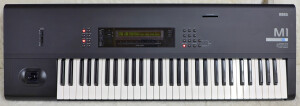View other reviews for this product:
« Legendary M1! »
Published on 10/16/12 at 15:03Workstation synth 61 keys velocity sensitive and aftertouch monaural.
Released in 1988.
16 voice polyphony, 8 part multi-timbral.
AI synthesis (2 CSOs, non-resonant two digital filters, 3 envelopes, 1 LFO, 2 digital multi-effects).
8 track sequencer, 10 songs, 100 patterns, 7700 notes.
100 programs and 100 combis editable memory. 100 and 100 combis progs additional card RAM / ROM.
M1 pitch stick: Pitch bend, modulation and modulation + Y-Y.
2 inputs for foot control / switch and one input for sustain pedal.
2 pairs of stereo audio outputs.
MIDI IN, OUT and THRU.
13.5 Kg
UTILIZATION
The use of M1 is really simple. This is also the first real workstation. And it is also the basis of the architecture of all other Korg synths next ... The M1 has 8 soft keys under the screen to access most often at all values of a given page. For example, the default page selection presets (Korg programs), displays a kind of quick edit with the most critical parameters (balance CSOs, filter, envelope, effect level ...). Combi mode, these buttons select the preset to play in each of the eight parts ... Very convenient! It is possible to change the sound quickly without going into publishing (especially useful for cutting effects recording ). Actually edit the sound is really not complicated, you can not get "lost" in M1. I also underlines the high quality of the keyboard (the same as the DX7) which allows him to take pride of place as a master keyboard in your config.
). Actually edit the sound is really not complicated, you can not get "lost" in M1. I also underlines the high quality of the keyboard (the same as the DX7) which allows him to take pride of place as a master keyboard in your config.
SOUNDS
Almost ALL presets have their original tube ^ ^ From Madonna (Piano PROG I41 8 ") Depeche Mode via The Orb (PROG I00 Universe), everyone used to the sounds of the M1 ... And because , samples and sound serious character (which lacks a bit today on the PCM synthesizers) and effects are fatal for some time to see beautiful (Flanger, Phaser 2, Set ...). It possible to expand the sonic palette via pairs of cards adding PCM multi-samples and presets.
It is possible to accurately mimic acoustic instruments (a reference to the brass and flute ^ ^), but excels especially in mixing sounds of hammers to strings saturated in samples flanger analogs synths or play a little sound good digital multi-diluted ... A feast for the compo!
OVERALL OPINION
I use it for about 93. I've done several albums with and I love more!
It is one of those rare synths have changed how to create instruments with electronics. Just like a Mini Moog, a DX7 or D50
In short, a classic to have!
Released in 1988.
16 voice polyphony, 8 part multi-timbral.
AI synthesis (2 CSOs, non-resonant two digital filters, 3 envelopes, 1 LFO, 2 digital multi-effects).
8 track sequencer, 10 songs, 100 patterns, 7700 notes.
100 programs and 100 combis editable memory. 100 and 100 combis progs additional card RAM / ROM.
M1 pitch stick: Pitch bend, modulation and modulation + Y-Y.
2 inputs for foot control / switch and one input for sustain pedal.
2 pairs of stereo audio outputs.
MIDI IN, OUT and THRU.
13.5 Kg
UTILIZATION
The use of M1 is really simple. This is also the first real workstation. And it is also the basis of the architecture of all other Korg synths next ... The M1 has 8 soft keys under the screen to access most often at all values of a given page. For example, the default page selection presets (Korg programs), displays a kind of quick edit with the most critical parameters (balance CSOs, filter, envelope, effect level ...). Combi mode, these buttons select the preset to play in each of the eight parts ... Very convenient! It is possible to change the sound quickly without going into publishing (especially useful for cutting effects recording
SOUNDS
Almost ALL presets have their original tube ^ ^ From Madonna (Piano PROG I41 8 ") Depeche Mode via The Orb (PROG I00 Universe), everyone used to the sounds of the M1 ... And because , samples and sound serious character (which lacks a bit today on the PCM synthesizers) and effects are fatal for some time to see beautiful (Flanger, Phaser 2, Set ...). It possible to expand the sonic palette via pairs of cards adding PCM multi-samples and presets.
It is possible to accurately mimic acoustic instruments (a reference to the brass and flute ^ ^), but excels especially in mixing sounds of hammers to strings saturated in samples flanger analogs synths or play a little sound good digital multi-diluted ... A feast for the compo!
OVERALL OPINION
I use it for about 93. I've done several albums with and I love more!
It is one of those rare synths have changed how to create instruments with electronics. Just like a Mini Moog, a DX7 or D50
In short, a classic to have!




